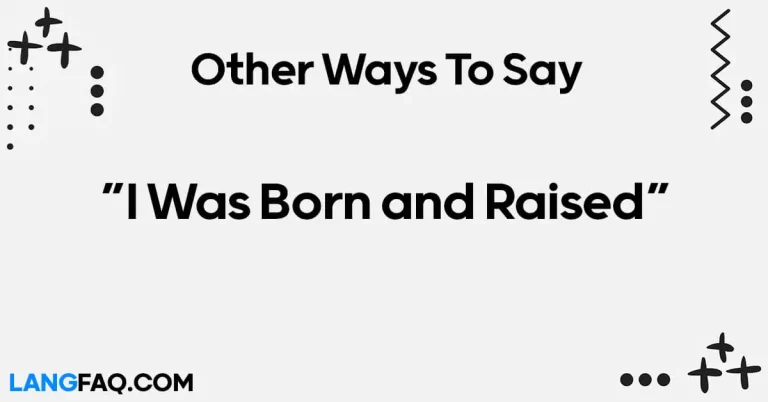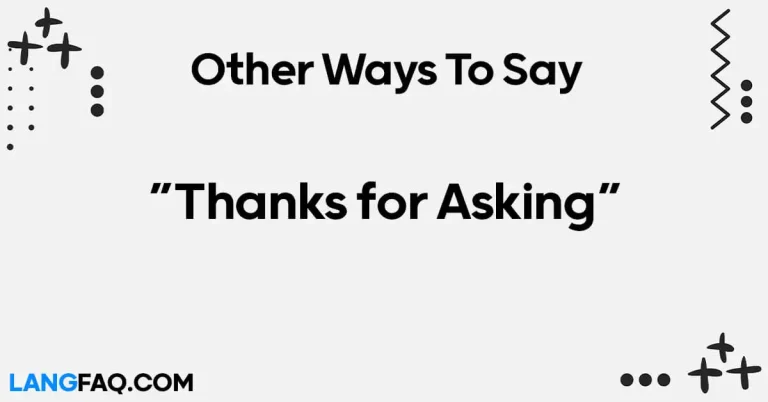In today’s fast-paced world, the phrase “I’m busy” has become a default response, often indicating a lack of time management or overwhelming workload. However, mastering the art of expressing busyness in different ways not only adds variety to communication but also conveys a more positive and organized image. In this comprehensive guide, we’ll explore 12 alternative ways to say “I’m busy” that enhance communication and time management skills, ensuring you navigate your tasks with efficiency and grace.
12 Other Ways to Say “I’m Busy”
Here are 12 alternative ways to say “I’m busy”:
- Occupied with tasks
- Engrossed in work
- Preoccupied with responsibilities
- Fully engaged at the moment
- Tied up with commitments
- Handling various projects
- Immersed in my workload
- Juggling multiple responsibilities
- Deeply involved in tasks
- In the midst of my duties
- Swamped with work
- Managing a hectic schedule
Here’s a table with the meaning and examples of the alternative ways to say “I’m busy”:
| Alternative Phrase | Meaning | Example |
|---|---|---|
| Occupied with tasks | Engaged in various tasks or activities | “I’m sorry, I’m occupied with tasks right now.” |
| Engrossed in work | Deeply focused on work or projects | “I’m engrossed in work, can we talk later?” |
| Preoccupied with responsibilities | Distracted or absorbed by duties | “I’m preoccupied with responsibilities at the moment.” |
| Fully engaged at the moment | Completely involved in current activities | “I’m fully engaged at the moment, can I get back to you later?” |
| Tied up with commitments | Busy with prior commitments or obligations | “I’m tied up with commitments today, maybe tomorrow?” |
| Handling various projects | Managing multiple projects or tasks | “I’m handling various projects simultaneously.” |
| Immersed in my workload | Deeply involved in my workload | “I’m immersed in my workload right now, can we reschedule?” |
| Juggling multiple responsibilities | Balancing numerous tasks or duties | “I’m juggling multiple responsibilities at the moment.” |
| Deeply involved in tasks | Engaged in tasks or assignments | “I’m deeply involved in tasks, let’s discuss it later.” |
| In the midst of my duties | Amidst ongoing duties or obligations | “I’m in the midst of my duties, can I call you back?” |
| Swamped with work | Overwhelmed or burdened with work | “I’m swamped with work today, can we meet tomorrow instead?” |
| Managing a hectic schedule | Handling a busy or demanding schedule | “I’m managing a hectic schedule right now, can we chat later?” |
These alternative phrases provide various ways to communicate busyness effectively while conveying different nuances of engagement and workload. Whether deeply focused on tasks or managing multiple responsibilities, incorporating these alternatives into your vocabulary enhances communication and clarity in conveying your current commitments.
Is It Correct to Say “I’m Busy”?
Yes, it is correct to say “I’m busy.”
This phrase is commonly used to convey that one is occupied or engaged in various activities or responsibilities and may not be available for other tasks or socializing at that moment.
“I’m busy” can be used in both formal and informal contexts to politely decline invitations, requests, or interruptions when one’s time or attention is already committed elsewhere.
Professional Mail Example With “I’m Busy”
Subject: Update on Project Progress
Dear [Recipient’s Name],
I hope this email finds you well.
I wanted to provide a quick update on the status of [Project Name]. As of now, I’m fully engaged in overseeing the implementation phase and ensuring that all tasks are being executed according to schedule.
I appreciate your interest in discussing [topic or request], but unfortunately, I’m currently swamped with project-related commitments. However, I’m committed to addressing your queries as soon as my schedule permits.
Thank you for your understanding and patience.
Best regards, [Your Name]
Occupied with Tasks: Managing Time Effectively
Being occupied with tasks is a common scenario in both personal and professional settings. It signifies being actively engaged in various activities or responsibilities, often requiring focus and attention to detail. Here’s how you can effectively use this phrase in different contexts:
Meaning and Usage:
When you’re occupied with tasks, it implies that your time is currently allocated to specific activities or duties. This phrase can be used to politely convey that you’re busy without sounding overwhelmed.
Formal Context:
In a professional setting, you can use this phrase to inform colleagues or clients about your current workload while maintaining a professional demeanor. For example:
Example Sentence: “Apologies for the delay in response, I’m currently occupied with tasks but will prioritize your request.”
Email Sample:
Subject: Update on Project Status Dear Team,
I hope this email finds you well. I wanted to provide a quick update on the project status. Currently, I’m occupied with tasks related to finalizing the budget report. I assure you that I’ll address your queries by the end of the day.
Thank you for your understanding and patience.
Best regards, [Your Name]
Informal Context:
In casual conversations with friends or family, you can use this phrase to explain why you may not be available for social activities or gatherings.
Example Sentence: “I can’t join you for dinner tonight; I’m occupied with tasks for tomorrow’s presentation.”
Variations:
- Colleague to Colleague: “I’m swamped with work right now.”
- Mentor to Mentee: “I’m currently tied up with project deadlines, but I can offer assistance later in the day.”
Pros and Cons:
Using “occupied with tasks” allows you to communicate busyness effectively while maintaining professionalism or informality, depending on the context. However, it may not convey the urgency of your workload compared to phrases like “swamped with work.”
Tips:
- Be specific about the tasks you’re occupied with to provide clarity to others.
- Avoid using this phrase excessively, as it may come across as a generic excuse for not being available.
Engrossed in Work: Deep Focus and Dedication
To be engrossed in work signifies being deeply immersed in tasks or projects, demonstrating a high level of focus and dedication. Let’s explore how this phrase can be utilized effectively:
Meaning and Usage:
When you’re engrossed in work, you’re completely absorbed in what you’re doing, often to the point of losing track of time. This phrase conveys intense concentration and commitment to the task at hand.
Formal Context:
In professional environments, using this phrase indicates your dedication to completing projects efficiently. It’s suitable for conveying to supervisors or clients that you’re fully invested in your work.
Example Sentence: “I’m currently engrossed in finalizing the project proposal, but I’ll address your concerns shortly.”
Email Sample:
Subject: Update on Project Progress Dear [Client/Supervisor],
I wanted to provide an update on the project progress. As of now, I’m deeply engrossed in refining the marketing strategy based on the latest market trends. Rest assured, I’ll share the revised proposal with you by the end of the week.
Thank you for your patience and understanding.
Best regards, [Your Name]
Informal Context:
In casual conversations, using this phrase can indicate to friends or family that you’re deeply focused on a task and may not be available for socializing.
Example Sentence: “I can’t chat right now; I’m engrossed in completing this assignment before the deadline.”
Variations:
- Colleague to Colleague: “I’m fully immersed in the project at the moment.”
- Mentor to Mentee: “When you’re engrossed in your work, ensure you take short breaks to avoid burnout.”
Pros and Cons:
“Engrossed in work” effectively communicates your intense focus and dedication, which can be beneficial in professional settings. However, it may also imply that you’re unavailable for interruptions or distractions.
Tips:
- Use this phrase when you genuinely need uninterrupted focus to convey the importance of the task.
- Balance being engrossed in work with taking breaks to maintain productivity and avoid burnout.
Preoccupied with Responsibilities: Managing Priorities with Care
To be preoccupied with responsibilities suggests being mentally occupied or concerned with various duties or obligations. Let’s delve into how this phrase can be employed effectively:
Meaning and Usage:
When you’re preoccupied with responsibilities, you’re mentally focused on fulfilling your duties or obligations. This phrase conveys a sense of diligence and commitment to fulfilling your roles.
Formal Context:
In professional settings, using this phrase indicates that you’re diligently attending to your assigned tasks or projects. It can be employed to inform colleagues or supervisors about your current workload.
Example Sentence: “I’m preoccupied with responsibilities related to the upcoming client presentation, but I’ll address your query as soon as possible.”
Email Sample:
Subject: Update on Project Status Dear Team,
I hope this email finds you well. I wanted to provide a quick update on the project status. Currently, I’m preoccupied with responsibilities related to finalizing the budget report. I assure you that I’ll address your queries by the end of the day.
Thank you for your understanding and cooperation.
Best regards, [Your Name]
Informal Context:
In informal conversations, this phrase can be used to explain to friends or family why you may not be available for social activities or gatherings.
Example Sentence: “I can’t join you for lunch today; I’m preoccupied with responsibilities at work.”
Variations:
- Colleague to Colleague: “I’m currently caught up with responsibilities for the upcoming deadline.”
- Mentor to Mentee: “It’s essential to prioritize your responsibilities and manage your time effectively to avoid feeling overwhelmed.”
Pros and Cons:
Using “preoccupied with responsibilities” demonstrates your commitment to fulfilling your duties but may not convey the specific tasks you’re focused on compared to other phrases.
Tips:
- Provide context when using this phrase to help others understand the nature of your responsibilities.
- Be mindful of using it too frequently, as it may come across as a generic excuse for not being available.
Fully Engaged at the Moment: Prioritizing Commitments with Precision
To be fully engaged at the moment indicates being completely involved or committed to the tasks or activities currently at hand. Let’s explore how this phrase can be utilized effectively:
Meaning and Usage:
When you’re fully engaged at the moment, you’re giving your undivided attention to the task or activity in front of you. This phrase conveys a sense of focus and dedication to the present moment.
Formal Context:
In professional environments, using this phrase demonstrates your commitment to completing tasks or projects with precision. It’s suitable for informing colleagues or clients that you’re actively involved in the current activities.
Example Sentence: “I’m fully engaged at the moment in reviewing the project proposal, but I’ll address your concerns shortly.”
Email Sample:
Subject: Update on Project Progress Dear [Client/Supervisor],
I wanted to provide an update on the project progress. As of now, I’m fully engaged in analyzing the market research data to refine our marketing strategy. Rest assured, I’ll share the updated proposal with you by the end of the week.
Thank you for your continued support and collaboration.
Best regards, [Your Name]
Informal Context:
In casual conversations, using this phrase can indicate to friends or family that you’re deeply involved in a task and may not be available for distractions.
Example Sentence: “I can’t talk right now; I’m fully engaged in completing this report before the deadline.”
Variations:
- Colleague to Colleague: “I’m currently invested in the project at the moment.”
- Mentor to Mentee: “When you’re fully engaged in your tasks, ensure you maintain a clear focus to achieve optimal results.”
Pros and Cons:
“Fully engaged at the moment” showcases your commitment and dedication to the task at hand but may also imply that you’re unavailable for interruptions or distractions.
Tips:
- Use this phrase when you genuinely need focused attention to convey the importance of the task.
- Set clear boundaries to avoid distractions and maintain your engagement with the task.
Tied Up with Commitments: Balancing Priorities Effectively
To be tied up with commitments suggests being entangled or occupied with various obligations or responsibilities. Let’s explore how this phrase can be effectively employed:
Meaning and Usage:
When you’re tied up with commitments, you’re indicating that your time and attention are currently dedicated to fulfilling prior obligations or responsibilities. This phrase conveys a sense of being busy but still in control of your schedule.
Formal Context:
In professional settings, using this phrase communicates to colleagues or clients that you’re currently unavailable due to prior commitments. It’s suitable for politely declining new tasks or requests.
Example Sentence: “I’m tied up with commitments related to the quarterly financial report, but I’ll attend to your request as soon as possible.”
Email Sample:
Subject: Update on Project Schedule Dear Team,
I hope this email finds you well. I wanted to provide an update on the project schedule. As of now, I’m tied up with commitments related to finalizing the budget allocation. I assure you that I’ll address any project-related queries by the end of the day.
Thank you for your patience and understanding.
Best regards, [Your Name]
Informal Context:
In informal conversations, this phrase can be used to explain to friends or family why you may not be available for social activities or gatherings.
Example Sentence: “I can’t make it to the movie tonight; I’m tied up with commitments for tomorrow’s presentation.”
Variations:
- Colleague to Colleague: “I’m currently swamped with commitments for the upcoming deadline.”
- Mentor to Mentee: “When you’re tied up with commitments, it’s essential to prioritize tasks based on urgency and importance.”
Pros and Cons:
Using “tied up with commitments” allows you to convey busyness while still maintaining professionalism or informality. However, it may not communicate the specific nature of your commitments compared to other phrases.
Tips:
- Provide context when using this phrase to help others understand the nature of your commitments.
- Be mindful of using it too frequently, as it may come across as a generic excuse for not being available.
Handling Various Projects: Multitasking with Precision
To handle various projects suggests managing multiple tasks or assignments simultaneously. Let’s delve into how this phrase can be effectively utilized:
Meaning and Usage:
When you’re handling various projects, you’re indicating that you’re actively managing multiple tasks or assignments concurrently. This phrase conveys a sense of multitasking and efficient time management.
Formal Context:
In professional environments, using this phrase demonstrates your ability to multitask and prioritize tasks effectively. It’s suitable for informing colleagues or supervisors about your workload and capacity.
Example Sentence: “I’m currently handling various projects, including the client presentation and marketing campaign, but I’ll make time to discuss the budget proposal.”
Email Sample:
Subject: Update on Project Assignments Dear [Client/Supervisor],
I hope this email finds you well. I wanted to provide an update on my current project assignments. As of now, I’m handling various projects, including the client presentation and marketing campaign. I assure you that I’ll allocate time to address any project-related queries promptly.
Thank you for your continued support and collaboration.
Best regards, [Your Name]
Informal Context:
In casual conversations, using this phrase can indicate to friends or family that you’re managing multiple responsibilities and may not be available for immediate socializing.
Example Sentence: “I can’t meet for coffee today; I’m handling various projects for work and need to focus.”
Variations:
- Colleague to Colleague: “I’m currently juggling multiple projects simultaneously.”
- Mentor to Mentee: “When handling various projects, it’s essential to prioritize tasks based on deadlines and importance.”
Pros and Cons:
“Handling various projects” highlights your multitasking abilities but may also imply that you’re managing a heavy workload, potentially leading to burnout if not managed effectively.
Tips:
- Use this phrase to convey your ability to manage multiple tasks efficiently.
- Prioritize tasks based on urgency and importance to avoid feeling overwhelmed by handling various projects simultaneously.
Immersed in My Workload: Diving Deep into Responsibilities
To be immersed in your workload signifies being deeply involved or engrossed in your assigned tasks or projects. Let’s explore how this phrase can be effectively employed:
Meaning and Usage:
When you’re immersed in your workload, you’re indicating that you’re fully absorbed and dedicated to completing your tasks or projects. This phrase conveys a sense of focus and commitment to achieving your goals.
Formal Context:
In professional settings, using this phrase demonstrates your dedication to your work and your commitment to delivering results. It’s suitable for informing colleagues or supervisors about your current workload.
Example Sentence: “I’m currently immersed in my workload, focusing on meeting the project deadlines, but I’ll make time to review the proposal later today.”
Email Sample:
Subject: Update on Project Progress Dear [Client/Supervisor],
I hope this email finds you well. I wanted to provide an update on the project progress. As of now, I’m deeply immersed in my workload, ensuring that all project milestones are met according to schedule. I assure you that I’ll address any project-related queries promptly.
Thank you for your understanding and support.
Best regards, [Your Name]
Informal Context:
In casual conversations, using this phrase can indicate to friends or family that you’re deeply focused on your work and may not be available for immediate socializing.
Example Sentence: “I can’t join you for dinner tonight; I’m immersed in my workload and need to finish this report.”
Variations:
- Colleague to Colleague: “I’m fully absorbed in my workload right now.”
- Mentor to Mentee: “When you’re immersed in your workload, it’s essential to maintain a clear focus to ensure quality results.”
Pros and Cons:
Using “immersed in my workload” showcases your dedication to your responsibilities but may also imply that you’re deeply engrossed in your tasks, potentially leading to work-life imbalance if not managed effectively.
Tips:
- Use this phrase to convey your commitment to meeting deadlines and delivering quality work.
- Take breaks and prioritize self-care to avoid feeling overwhelmed or burnt out when immersed in your workload.
Juggling Multiple Responsibilities: Balancing Tasks with Precision
To juggle multiple responsibilities signifies managing various tasks or duties simultaneously. Let’s delve into how this phrase can be effectively utilized:
Meaning and Usage:
When you’re juggling multiple responsibilities, you’re indicating that you’re handling numerous tasks or obligations concurrently. This phrase conveys a sense of multitasking and efficient time management.
Formal Context:
In professional environments, using this phrase demonstrates your ability to prioritize tasks and manage your workload effectively. It’s suitable for informing colleagues or supervisors about your capacity to handle multiple responsibilities.
Example Sentence: “I’m currently juggling multiple responsibilities, including project management and client meetings, but I’ll prioritize our discussion this afternoon.”
Email Sample:
Subject: Update on Task Allocation Dear Team,
I hope this email finds you well. I wanted to provide an update on my current task allocation. As of now, I’m juggling multiple responsibilities, including project management and client meetings. I assure you that I’ll allocate time to address any urgent matters promptly.
Thank you for your cooperation and understanding.
Best regards, [Your Name]
Informal Context:
In casual conversations, using this phrase can indicate to friends or family that you’re managing various commitments and may not be available for immediate socializing.
Example Sentence: “I can’t make it to the party tonight; I’m juggling multiple responsibilities and need to catch up on work.”
Variations:
- Colleague to Colleague: “I’m currently managing multiple tasks simultaneously.”
- Mentor to Mentee: “When juggling multiple responsibilities, it’s essential to prioritize tasks based on deadlines and importance.”
Pros and Cons:
“Juggling multiple responsibilities” highlights your multitasking abilities but may also imply that you’re managing a heavy workload, potentially leading to stress if not managed effectively.
Tips:
- Use this phrase to convey your ability to handle multiple tasks efficiently.
- Prioritize tasks based on urgency and importance to avoid feeling overwhelmed when juggling multiple responsibilities.
Deeply Involved in Tasks: Committing to Excellence
To be deeply involved in tasks suggests being fully engaged and committed to completing specific assignments or projects. Let’s explore how this phrase can be effectively employed:
Meaning and Usage:
When you’re deeply involved in tasks, you’re indicating that you’re fully committed to achieving excellence in your work. This phrase conveys a sense of dedication and passion for the tasks at hand.
Formal Context:
In professional settings, using this phrase demonstrates your commitment to delivering high-quality results. It’s suitable for informing colleagues or supervisors about your level of involvement in specific projects or assignments.
Example Sentence: “I’m deeply involved in tasks related to the product launch, ensuring that all aspects are meticulously planned and executed.”
Email Sample:
Subject: Update on Project Progress Dear [Client/Supervisor],
I hope this email finds you well. I wanted to provide an update on the project progress. As of now, I’m deeply involved in tasks related to the marketing campaign, focusing on maximizing our reach and engagement. I assure you that I’ll keep you updated on any significant developments.
Thank you for your trust and collaboration.
Best regards, [Your Name]
Informal Context:
In casual conversations, using this phrase can indicate to friends or family that you’re fully committed to completing your tasks and may not be available for immediate socializing.
Example Sentence: “I can’t hang out tonight; I’m deeply involved in tasks for tomorrow’s presentation.”
Variations:
- Colleague to Colleague: “I’m fully committed to the project tasks at the moment.”
- Mentor to Mentee: “When deeply involved in tasks, it’s crucial to maintain attention to detail and strive for excellence.”
Pros and Cons:
Using “deeply involved in tasks” highlights your dedication to achieving excellence but may also imply that you’re fully immersed in your work, potentially leading to neglecting other aspects of your life if not managed effectively.
Tips:
- Use this phrase to convey your commitment to delivering high-quality results.
- Set boundaries and prioritize self-care to maintain a healthy work-life balance when deeply involved in tasks.
In the Midst of My Duties: Navigating Responsibilities with Precision
To be in the midst of your duties signifies being actively engaged in fulfilling various responsibilities or obligations. Let’s delve into how this phrase can be effectively utilized:
Meaning and Usage:
When you’re in the midst of your duties, you’re indicating that you’re currently occupied with fulfilling your responsibilities. This phrase conveys a sense of being actively engaged in managing your tasks.
Formal Context:
In professional environments, using this phrase demonstrates your commitment to fulfilling your duties diligently. It’s suitable for informing colleagues or supervisors about your current engagement in specific tasks or projects.
Example Sentence: “I’m currently in the midst of my duties, reviewing client feedback and addressing any concerns promptly.”
Email Sample:
Subject: Update on Task Progress Dear Team,
I hope this email finds you well. I wanted to provide an update on my current task progress. As of now, I’m in the midst of my duties, ensuring that all client queries are handled with efficiency and professionalism. I assure you that I’ll prioritize urgent matters and provide timely responses.
Thank you for your collaboration and support.
Best regards, [Your Name]
Informal Context:
In casual conversations, using this phrase can indicate to friends or family that you’re actively engaged in fulfilling your responsibilities and may not be available for immediate socializing.
Example Sentence: “I can’t talk right now; I’m in the midst of my duties and need to focus on completing these tasks.”
Variations:
- Colleague to Colleague: “I’m currently in the thick of my responsibilities.”
- Mentor to Mentee: “When in the midst of your duties, it’s essential to prioritize tasks and manage your time effectively.”
Pros and Cons:
Using “in the midst of my duties” emphasizes your active engagement in fulfilling responsibilities but may also imply that you’re currently occupied with tasks, potentially limiting your availability for other activities if not managed effectively.
Tips:
- Use this phrase to convey your commitment to fulfilling responsibilities diligently.
- Prioritize tasks based on urgency and importance to avoid feeling overwhelmed when in the midst of your duties.
Swamped with Work: Managing Heavy Workload Effectively
To be swamped with work indicates being overwhelmed or inundated with a significant amount of tasks or responsibilities. Let’s explore how this phrase can be effectively employed:
Meaning and Usage:
When you’re swamped with work, you’re indicating that you’re facing a heavy workload that may be challenging to manage. This phrase conveys a sense of being overwhelmed by the volume of tasks or responsibilities.
Formal Context:
In professional settings, using this phrase communicates to colleagues or supervisors that you’re facing a substantial workload that may require additional support or resources.
Example Sentence: “I’m currently swamped with work, but I’m prioritizing tasks to ensure that deadlines are met.”
Email Sample:
Subject: Request for Deadline Extension Dear [Client/Supervisor],
I hope this email finds you well. I wanted to reach out regarding the upcoming deadline for the project. Unfortunately, I’m currently swamped with work, and I’m concerned about meeting the deadline without compromising on quality. Would it be possible to discuss a deadline extension to ensure that we deliver the best results?
Thank you for your understanding and cooperation.
Best regards, [Your Name]
Informal Context:
In casual conversations, using this phrase can indicate to friends or family that you’re overwhelmed by your workload and may not be available for social activities or gatherings.
Example Sentence: “I can’t make it to the party tonight; I’m swamped with work and need to catch up on my tasks.”
Variations:
- Colleague to Colleague: “I’m currently buried under a mountain of tasks.”
- Mentor to Mentee: “When swamped with work, it’s crucial to prioritize tasks and communicate effectively with your team to manage the workload efficiently.”
Pros and Cons:
Using “swamped with work” effectively conveys the magnitude of your workload but may also indicate that you’re struggling to cope with the demands, potentially leading to stress if not managed effectively.
Tips:
- Use this phrase to communicate the urgency of your workload and potentially seek assistance or support.
- Prioritize tasks and delegate responsibilities where possible to manage a heavy workload effectively.
Managing a Hectic Schedule: Navigating Time Constraints with Precision
To manage a hectic schedule signifies efficiently handling a busy or demanding timetable. Let’s delve into how this phrase can be effectively utilized:
Meaning and Usage:
When you’re managing a hectic schedule, you’re indicating that you’re actively organizing and prioritizing your time to accommodate various commitments and obligations. This phrase conveys a sense of adeptly navigating through busy periods.
Formal Context:
In professional environments, using this phrase demonstrates your ability to manage time effectively and meet deadlines despite a demanding schedule. It’s suitable for informing colleagues or supervisors about your availability and capacity to handle multiple tasks.
Example Sentence: “I’m currently managing a hectic schedule, but I’ll make time to review the project proposal later today.”
Email Sample:
Subject: Update on Meeting Availability Dear Team,
I hope this email finds you well. I wanted to provide an update on my meeting availability for the upcoming week. As of now, I’m managing a hectic schedule, but I’ve allocated time slots for project discussions and updates. Please let me know if there are any urgent matters that require immediate attention.
Thank you for your cooperation and understanding.
Best regards, [Your Name]
Informal Context:
In casual conversations, using this phrase can indicate to friends or family that you’re busy but still actively managing your time to accommodate various commitments.
Example Sentence: “I can’t chat right now; I’m managing a hectic schedule and need to focus on my tasks.”
Variations:
- Colleague to Colleague: “I’m currently juggling a jam-packed schedule.”
- Mentor to Mentee: “When managing a hectic schedule, it’s essential to prioritize tasks and allocate time for breaks to avoid burnout.”
Pros and Cons:
Using “managing a hectic schedule” showcases your time management skills but may also indicate that you’re experiencing high levels of stress or pressure if not managed effectively.
Tips:
- Use this phrase to convey your ability to navigate through busy periods and meet deadlines.
- Implement time management strategies such as prioritizing tasks, setting realistic deadlines, and delegating responsibilities to manage a hectic schedule effectively.
Occupied with Priorities: Balancing Tasks with Care
To be occupied with priorities signifies being actively engaged in managing important tasks or commitments. Let’s explore how this phrase can be effectively employed:
Meaning and Usage:
When you’re occupied with priorities, you’re indicating that your time and attention are focused on fulfilling essential tasks or obligations. This phrase conveys a sense of diligently managing your responsibilities.
Formal Context:
In professional settings, using this phrase communicates to colleagues or supervisors that you’re actively prioritizing tasks to meet objectives efficiently.
Example Sentence: “I’m currently occupied with priorities, ensuring that critical deadlines are met and objectives are achieved.”
Email Sample:
Subject: Update on Project Progress Dear [Client/Supervisor],
I hope this email finds you well. I wanted to provide an update on the project progress. As of now, I’m occupied with priorities related to finalizing the project deliverables. I assure you that I’ll keep you informed of any significant developments.
Thank you for your trust and collaboration.
Best regards, [Your Name]
Informal Context:
In casual conversations, using this phrase can indicate to friends or family that you’re managing important tasks and may not be available for immediate socializing.
Example Sentence: “I can’t hang out tonight; I’m occupied with priorities and need to finish these tasks.”
Variations:
- Colleague to Colleague: “I’m currently focused on top priorities to ensure project success.”
- Mentor to Mentee: “When occupied with priorities, it’s essential to stay organized and maintain clarity on objectives to achieve desired outcomes.”
Pros and Cons:
Using “occupied with priorities” effectively conveys your commitment to managing important tasks but may also indicate that you’re facing a heavy workload, potentially leading to stress if not managed effectively.
Tips:
- Use this phrase to communicate the importance of tasks and the need to prioritize effectively.
- Implement time management techniques such as setting goals, prioritizing tasks, and delegating responsibilities to manage occupied priorities efficiently.
Tackling Essential Tasks: Navigating Responsibilities with Precision
To tackle essential tasks signifies efficiently addressing critical assignments or obligations. Let’s delve into how this phrase can be effectively utilized:
Meaning and Usage:
When you’re tackling essential tasks, you’re indicating that you’re actively addressing important assignments or responsibilities. This phrase conveys a sense of efficiently managing your workload to achieve desired outcomes.
Formal Context:
In professional environments, using this phrase demonstrates your ability to prioritize tasks and meet objectives effectively. It’s suitable for informing colleagues or supervisors about your progress in completing essential assignments.
Example Sentence: “I’m currently tackling essential tasks, focusing on meeting project milestones and delivering results.”
Email Sample:
Subject: Progress Update on Key Initiatives Dear Team,
I hope this email finds you well. I wanted to provide a progress update on key initiatives. As of now, I’m tackling essential tasks related to project implementation and stakeholder engagement. I assure you that I’ll keep you updated on our progress and address any concerns promptly.
Thank you for your continued support and collaboration.
Best regards, [Your Name]
Informal Context:
In casual conversations, using this phrase can indicate to friends or family that you’re actively managing important tasks and may not be available for immediate socializing.
Example Sentence: “I can’t talk right now; I’m tackling essential tasks and need to focus on completing them.”
Variations:
- Colleague to Colleague: “I’m currently handling critical tasks to ensure project success.”
- Mentor to Mentee: “When tackling essential tasks, it’s crucial to maintain focus and prioritize effectively to achieve desired outcomes.”
Pros and Cons:
Using “tackling essential tasks” highlights your ability to address critical assignments but may also indicate that you’re facing a heavy workload, potentially leading to stress if not managed effectively.
Tips:
- Use this phrase to communicate progress on important assignments and the importance of prioritizing tasks effectively.
- Break down tasks into manageable components and allocate time for completion to tackle essential tasks efficiently.
FAQs:
- What should I do if I’m genuinely busy?If you’re genuinely busy, it’s essential to communicate your availability clearly. Use phrases like “I have a full schedule at the moment, but I can make time for this later” to convey your busyness while still being accommodating.
- How can I politely decline additional tasks when I’m already busy?Politely declining additional tasks requires tact and diplomacy. You can say, “I’m currently fully committed to my current projects, but I can revisit this request once I have some availability.”
- Is it okay to use these alternatives in professional settings?Absolutely! These alternatives are suitable for both professional and personal contexts. They convey your busyness while maintaining professionalism and courtesy.
- What if someone insists on your immediate attention despite your busyness?In such situations, it’s crucial to assert your boundaries politely. You can say, “I understand the urgency, but I’m currently tied up with other commitments. Can we schedule a time to address this later?”
- How can I effectively manage my time amidst numerous responsibilities?Time management requires prioritization and organization. Utilize tools like calendars, to-do lists, and prioritization techniques to manage your tasks effectively.
- Are there any phrases to convey busyness without sounding overwhelmed?Yes, phrases like “I’m fully engaged at the moment” or “I have several commitments to attend to” convey busyness without implying overwhelm.
Conclusion:
Mastering the art of expressing busyness positively is essential for effective communication and time management. By incorporating these 12 alternative ways to say “I’m busy” into your vocabulary, you can convey your engagements with clarity, professionalism, and positivity. Remember, it’s not just about being busy; it’s about managing your time efficiently and maintaining a healthy work-life balance.







